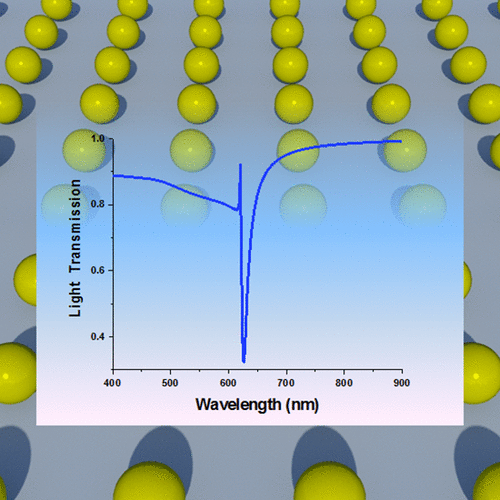当前位置:
X-MOL 学术
›
Chem. Rev.
›
论文详情
Our official English website, www.x-mol.net, welcomes your
feedback! (Note: you will need to create a separate account there.)
Plasmonic Surface Lattice Resonances: A Review of Properties and Applications.
Chemical Reviews ( IF 51.4 ) Pub Date : 2018-06-04 , DOI: 10.1021/acs.chemrev.8b00243 V G Kravets 1 , A V Kabashin 2, 3 , W L Barnes 4 , A N Grigorenko 1
Chemical Reviews ( IF 51.4 ) Pub Date : 2018-06-04 , DOI: 10.1021/acs.chemrev.8b00243 V G Kravets 1 , A V Kabashin 2, 3 , W L Barnes 4 , A N Grigorenko 1
Affiliation

|
When metal nanoparticles are arranged in an ordered array, they may scatter light to produce diffracted waves. If one of the diffracted waves then propagates in the plane of the array, it may couple the localized plasmon resonances associated with individual nanoparticles together, leading to an exciting phenomenon, the drastic narrowing of plasmon resonances, down to 1-2 nm in spectral width. This presents a dramatic improvement compared to a typical single particle resonance line width of >80 nm. The very high quality factors of these diffractively coupled plasmon resonances, often referred to as plasmonic surface lattice resonances, and related effects have made this topic a very active and exciting field for fundamental research, and increasingly, these resonances have been investigated for their potential in the development of practical devices for communications, optoelectronics, photovoltaics, data storage, biosensing, and other applications. In the present review article, we describe the basic physical principles and properties of plasmonic surface lattice resonances: the width and quality of the resonances, singularities of the light phase, electric field enhancement, etc. We pay special attention to the conditions of their excitation in different experimental architectures by considering the following: in-plane and out-of-plane polarizations of the incident light, symmetric and asymmetric optical (refractive index) environments, the presence of substrate conductivity, and the presence of an active or magnetic medium. Finally, we review recent progress in applications of plasmonic surface lattice resonances in various fields.
中文翻译:

等离子体表面晶格共振:特性和应用的审查。
当金属纳米颗粒以有序阵列排列时,它们可能散射光以产生衍射波。如果然后其中一个衍射波在阵列平面内传播,它可能将与单个纳米粒子相关的局部等离振子共振耦合在一起,从而导致令人兴奋的现象,即等离激元共振急剧缩小,光谱宽度降低到1-2 nm 。与典型的单粒子共振线宽度> 80 nm相比,这是一个巨大的改进。这些衍射耦合等离子体激元共振的非常高的品质因数,通常称为等离子体表面晶格共振,以及相关的影响,使该主题成为基础研究非常活跃而令人兴奋的领域,并且越来越多地,已经研究了这些共振在通信,光电,光伏,数据存储,生物传感和其他应用的实际设备开发中的潜力。在这篇综述文章中,我们描述了等离激元表面晶格共振的基本物理原理和性质:共振的宽度和质量,光相的奇异性,电场增强等。我们特别注意它们的激发条件在不同的实验架构中,需要考虑以下因素:入射光的面内和面外偏振,对称和不对称的光学(折射率)环境,基板电导率的存在以及活性或磁性介质的存在。最后,
更新日期:2018-06-04
中文翻译:

等离子体表面晶格共振:特性和应用的审查。
当金属纳米颗粒以有序阵列排列时,它们可能散射光以产生衍射波。如果然后其中一个衍射波在阵列平面内传播,它可能将与单个纳米粒子相关的局部等离振子共振耦合在一起,从而导致令人兴奋的现象,即等离激元共振急剧缩小,光谱宽度降低到1-2 nm 。与典型的单粒子共振线宽度> 80 nm相比,这是一个巨大的改进。这些衍射耦合等离子体激元共振的非常高的品质因数,通常称为等离子体表面晶格共振,以及相关的影响,使该主题成为基础研究非常活跃而令人兴奋的领域,并且越来越多地,已经研究了这些共振在通信,光电,光伏,数据存储,生物传感和其他应用的实际设备开发中的潜力。在这篇综述文章中,我们描述了等离激元表面晶格共振的基本物理原理和性质:共振的宽度和质量,光相的奇异性,电场增强等。我们特别注意它们的激发条件在不同的实验架构中,需要考虑以下因素:入射光的面内和面外偏振,对称和不对称的光学(折射率)环境,基板电导率的存在以及活性或磁性介质的存在。最后,











































 京公网安备 11010802027423号
京公网安备 11010802027423号